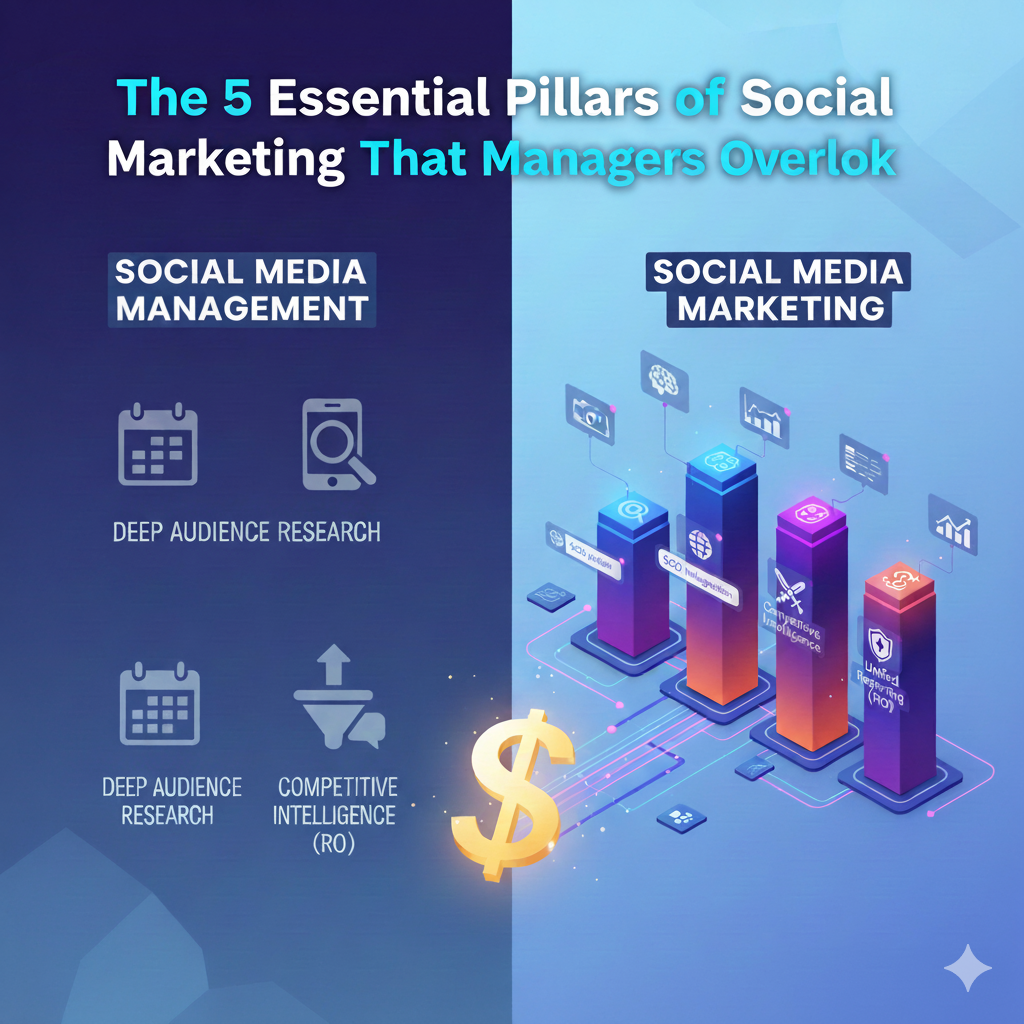Social media management is about posting. Social media marketing (SMM) is about profits. Many businesses focus entirely on the first, leaving valuable money and growth on the table.If you’re only checking your content calendar and replying to comments, you’re missing the strategic elements that transform your social presence into a powerful revenue engine. Understanding the difference in cost and reach between social media marketing vs traditional marketing is critical for maximizing your budget. At Digipeddle Technologies, we know that true growth comes from integrating social efforts with core business objectives.
This guide highlights the five crucial, often-missed strategic pillars that elevate your game far beyond simple management.
Pillar 1: Deep Audience Research (The “Why” Before the “What”)
Many social media managers rely on basic follower demographics. Social media marketing demands a deeper understanding of the customer journey.
You aren’t just selling a product; you’re solving a problem. To do that effectively, you must know your audience’s biggest frustrations and how they talk about them online.
Actionable Insights from Deep Research:
- Behavioral Triggers: What events or emotional states make them search for your solution?
- Platform Alignment: Your audience may be on Instagram, but where do they go when they are ready to buy? (This distinction is key in social media marketing vs social media management).
- Language Mapping: Use the exact words and phrases your audience uses. This drastically improves your ad copy and organic relevance.
This foundational research is the strategic difference between general posting and targeted social media marketing.
Pillar 2: Conversion Rate Optimization (CRO) Integration
You posted a beautiful ad. You got thousands of clicks. But did you make any sales? If the answer is no, you have a CRO problem.
Social media marketing doesn’t end when a user clicks your link. It only ends when they complete a goal (a purchase, a sign-up, or a download). Managers often overlook the critical post-click experience.
Optimizing Your Conversion Funnel:
- Dedicated Landing Pages: Never send paid traffic to your homepage. Create fast-loading, single-goal landing pages that align perfectly with the ad message.
- Friction Reduction: Review your checkout or sign-up process. Can you reduce the number of clicks required to convert? Fewer fields equal more conversions.
- A/B Testing: You must constantly test your button colors, headline copy, and form layouts. Don’t guess—use data to decide the fastest path to transaction.
This seamless integration of social media with optimized landing pages is what separates basic social media management from advanced social media marketing.
Pillar 3: SEO for Social Media Content
While social media marketing vs traditional marketing has clear differences, they share one key strategy: being found when people search.
Yes, people use search engines within social apps! Optimizing your profile and content helps you capture highly relevant intent-based traffic.
How to Become Searchable on Social:
- Keyword-Rich Profiles: Your bio, “About” section, and profile description must include the services you offer (e.g., “We offer expert B2B SEO services and social media marketing.”).
- Video Titles and Descriptions: YouTube, Facebook, and Instagram Reels/Videos are powerful search engines. Include long-tail keywords in titles and captions.
- Hashtag Strategy: Move beyond generic hashtags. Use hyper-specific, intent-based tags that align with customer queries.
Using SEO strategies in your social plan helps you attract traffic from users actively looking for a solution, making their path to a transaction much shorter.
Pillar 4: Competitive Intelligence and Benchmarking
Your competitors aren’t just other businesses; they are the accounts fighting for the same attention in your followers’ feeds. Social media marketing requires you to continuously assess and outperform your competition.
Managers often only track their own metrics. Strategists track the entire landscape to identify gaps and opportunities for their brand, Digipeddle Technologies.
Turning Competitors into Insights:
- Engagement Audit: Analyze which type of content gets the most shares and saves for your top competitors. Don’t copy; create an improved version.
- Ad Spend Discovery: Identify which competitor ads have been running the longest. Long-running ads usually mean they are profitable, giving you a template for your own social media marketing campaigns.
- Customer Service Gaps: Look at the comments on competitor pages. What are their followers complaining about? Address those exact pain points in your own social media marketing to acquire new customers.
This strategic intelligence helps your brand stand out and drives immediate conversion opportunities.
Pillar 5: Unified Reporting (Tying Social to Revenue)
This is the most critical difference between social media marketing vs social media management. Management reports usually focus on vanity metrics like likes, comments, and follower growth. Marketing reports focus solely on Return on Investment (ROI).
If your reports can’t directly show how many deals closed or how much revenue was generated by a specific Facebook campaign, you are managing, not marketing.
Essential Metrics for Revenue Generation:
- Cost Per Acquisition (CPA): How much did it cost, down to the penny, to acquire one customer via social media?
- Customer Lifetime Value (CLV): How much is that new social media customer worth over the duration of their relationship with your brand?
- Marketing-Qualified Leads (MQLs): The number of high-intent leads generated directly from your social campaigns.
True social media marketing success relies on a clear, data-driven line connecting a tweet or a post to a completed purchase.
Conclusion
Stop letting your social efforts operate in a vacuum. The era of focusing only on basic social media management is over. To truly compete in the modern digital landscape, you must implement these five strategic pillars.
At Digipeddle Technologies, we help businesses like yours transition from simple posting to powerful social media marketing that drives tangible revenue.
Your Next Steps to Strategic Growth:
- Audit: Let us audit your current social media efforts to show you exactly where the leaks in your funnel are.
- Consult: Book a free consultation with our B2B SEO services and social media marketing agency experts.
- Grow: Start transforming your social presence into a predictable lead and revenue source.
Contact Us today and get a free quote on comprehensive social media strategy services that deliver real results.







